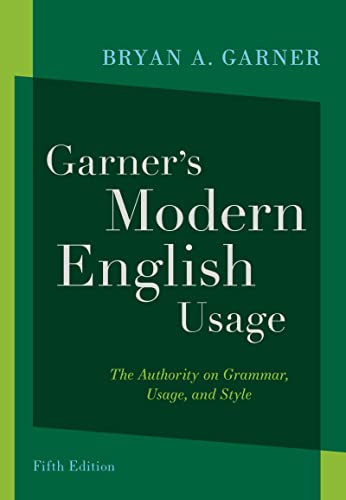First, let’s be clear about what “usage” means. It isn’t grammar, though the two are related and often treated together in such page-turners as The McGraw-Hill Handbook of English Grammar and Usage and The Chicago Guide to Grammar, Usage, and Punctuation. Grammar is a language’s set of rules for putting words together; usage is how people actually put words together. Remember it this way: usage is how language is used.
So Bryan A. Garner didn’t release a fifth edition of his Modern English Usage to explain the difference between coordinate and subordinate clauses—that hasn’t changed since 2016, when the previous edition was published. He’s here to update us on changes in how people speak and write in real life. Six years ago, for instance, using “they” as an alternative to “he” or “she,” Garner wrote, “sets many literate Americans’ teeth on edge.” As his new guide notes, the Chicago Manual of Style, New York Times, and Associated Press all now allow it.
To chart such evolutions, he’s devised a “language-change index,” consisting of five stages, from the emergence of a variant to its widespread acceptance. Which stage a word belongs in isn’t always clear. He tentatively puts “they” as a third-person singular in Stage 5, but given his description of Stage 4 usage—generally adopted but “opposed on cogent grounds by a few linguistic stalwarts”—you could argue it’s the latter. Surely it draws at least as much opposition as other Stage 4 specimens: “impact” as a verb and “hone in” for “home in.”
The subjectivity of these distinctions may rankle, but they’re not entirely judgment calls. Among the guide’s many virtues is its leveraging of data; Garner draws on Google’s database of English-language books—the largest in existence—to offer comparisons between the frequency of one usage versus another. “In modern print sources,” he notes, “homing in on the . . .” predominates over “honing in on the . . .” by a 2-to-1 margin.
Does all this seem like a bit much to, um, home in on? Maybe for some. But for anyone interested in language, it’s catnip. (This might be a good time to mention that I’m a professional copy editor.) The terrain Garner covers is as varied it is extensive; entries address everything from inclusive language to the correct placement of “only” in a sentence. Better still, he conducts readers through it with good sense, wit, and erudition.
Exemplifying these first and third qualities is his discussion of ending sentences with a preposition. You’re probably aware that some people consider this practice a mistake; you may even be one of them. Garner isn’t. On the basis of both history and what sounds natural today, he defends the terminal preposition. The prohibition against it, he writes, originated in the eighteenth century, when English grammarians looked to Latin as their model. (In Latin, prepositions always precede the nouns they modify—the word’s root means “placed before”—making it impossible for them to end sentences.) But, Garner points out, “Latin grammar should never straitjacket English grammar.” A perfectly sensible attitude: English is a Germanic language, after all. He favors, as I do, the smoothness of “people worth talking to” over “people to whom it is worth talking.”
As impressive as his conversance with English’s history is Garner’s awareness of present-day trends. The “like” entry notes not only traditional uses of the word (as a preposition and conjunction) but more recent functions. He catalogs a whopping five uses, among them the “quotative” (“She was like, ‘Hell no!’”), the “approximative” (“Isn’t that movie, like, five hours long?”), and the filler—which he labels, in a scholarly flourish, the “dummy-word.” (I was just, like, standing there when some, like, homeless guy came over and started to, like, freak out.”)
Those uninterested in such parsing may prefer the entries for “race-related terms,” which dispenses historically grounded advice on identifying people by race (Hispanic? Latino? Latina? Latinx?), and “they,” which delves into the pronoun’s use as an alternative to “he” or “she.” Garner tracks the evolution of the third-person-singular “they,” starting in the 1300s, when it sometimes referred to unspecified individuals. (It’s still used that way today in such sentences as “This style guide will enlighten the reader in ways they never expected.”) But only in the 21st century has “they” been applied to specific, often nonbinary, individuals—as in “Alex asked that they be given a promotion.” This usage, Garner notes, took off with the rise of the transgender-rights movement following Obergefell v. Hodges.
Even more striking than Garner’s knowledgeability is the empathy he urges. I remember, shortly after becoming a copy editor at The New Yorker in June 2020, David Remnick announcing that the publication would begin capitalizing “Black.” I bristled at the inconsistency, if not inequity, of leaving “brown” and “white” lowercase. Remnick acknowledged such counterarguments, as does Garner, but decided that showing respect to Black people mattered more, especially at a time when racial-justice protests in the wake of George Floyd’s murder were convulsing the country. Other news outlets had already begun capping the word; perhaps, as Garner speculates, “it was the editorial expression of the need for social justice.” My initial resistance now past, I’ve come to appreciate Garner and Reminck’s stance. Writing “a Black man” instead of “a black man” seems less a violation of principle than a prioritization of people over a style rule. Or maybe it’s an exchange of one rule for another: instead of favoring consistency above all, first consider the perspective of those being referred to.
The seriousness with which Garner treats social-justice issues doesn’t preclude playfulness on other topics; nor does his familiarity with dangling modifiers and sentence fragments keep him from thinking creatively about grammar. In the “skunked terms” entry, both characteristics are on display. Garner’s own coinage, the label denotes words or phrases caught between meanings. He cites “transpire,” which once meant “come to light” but now more commonly appears as a slightly pretentious synonym for “happen.” This and other such words give rise to two factions: an old guard against the altered usage and another camp okay with it, possibly even unaware of the initial sense. Because the first group won’t countenance the new use and members of the second might not recognize the original one, Garner recommends avoiding the word altogether, tinged as it is with “a bad odor.” With time, the odor fades, as it has from “contact” as a verb (though it still clings to “impact”).
Supplementing the word histories Garner charts are quotations from language experts, writers, politicians, newspapers, magazines, and other publications, some dating back hundreds of years. Many are enlisted to support the case for a particular use; Anthony Burgess gets quoted to show the permissibility of ending sentences with a preposition: “Poetry, as Dr. Johnson said, is untranslatable and hence, if it is good, preserves the language it is written in.” Others serve the opposite purpose, illustrating bad usage. This sentence from a USA Today article, for instance, has a misplaced “only”: “The prosecution was hindered from seeking a conviction on attempted manslaughter charges because Seles elected not to testify at the hearing and only provided her medical records shortly before the trial was to begin.” (Italics mine.) Logically, the end of that sentence should read “. . . and provided her medical records only shortly before the trial was to begin.” (The point is that Seles provided her medical records last-minute, not that she failed to provide additional records.)
Logic is, as Garner realizes, a cornerstone of usage and grammar. The purpose of his recommendations—and that of grammar, ultimately—is to help people make themselves understood. Yet he recognizes that even logic has its limits. “It is no use trying to explain why we say, on the one hand, that pair of shoes is getting old, but on the other hand, the pair were perfectly happy after their honeymoon,” he writes. (Italics his.) In Garner’s view, the best course is to “follow idiom and usage” but “otherwise apply logic.” Such advice circumvents the descriptivism-prescriptivism binary often invoked in discussions of grammar. Garner is saying, essentially, be descriptivist when you can and prescriptivist when you can’t.
Logic’s sister is clarity. If a sentence is a muddle, the thinking behind it probably is too. Take this humdinger from a Detroit News article: “States were further required to limit soot from power plants, cars and other sources to 2.5 microns, or 28 times smaller than [who can be sure what this means?] the width of a human hair.” (Bracketed text Garner’s.) A lesser, though more common, confusion is the misuse of “if” for “whether.” As Garner puts it, “Use if for a conditional idea, whether for an alternative or possibility.” This distinction is meant to facilitate understanding. If your grammatically savvy friend says, “Let me know whether you can make it,” they want a response either way. If they say, “Let me know if you can make it,” you’re expected to respond only if you’re a yes.
Like the dictionary, Garner’s Modern English Usage is more to be consulted than read cover to cover. But if you have the stamina to power though its 1,187 pages—not counting the glossary of language-related terms or the chronology of books about usage, starting in 1740—delights aplenty await. This review has offered but a sampling.





























































